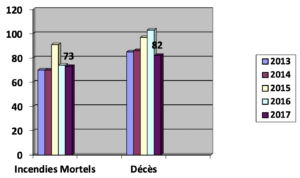Annual Report of the CVFSA Ontario Director to the 2018 AGM
 In October of 2017, the Canadian Volunteer Fire Service Association posted a notice for the office of Director for the Province of Ontario. I was privileged to be selected and installed in this position at the beginning of a Board of Directors teleconference on Feb 28, 2018. In this, I am impressed with the fact that CVFSA Directors regularly make use of fiscally responsible means to conduct business of this association.
In October of 2017, the Canadian Volunteer Fire Service Association posted a notice for the office of Director for the Province of Ontario. I was privileged to be selected and installed in this position at the beginning of a Board of Directors teleconference on Feb 28, 2018. In this, I am impressed with the fact that CVFSA Directors regularly make use of fiscally responsible means to conduct business of this association.
Ontario’s firefighting community is unique in its own way, yet shares many of the same issues faced by other jurisdictions. Provincially our service is governed according to the Fire Protection and Prevention Act 1997 and the Fire Code is a regulation under this Act. Directives are issued by the Ontario Fire Marshal under authority of clause 9.(1)(b) in the Fire Protection and Prevention Act when there is a need to achieve consistency in the application of certain technical or administrative requirements.
 According to the Ministry of Community Safety & Correctional Services (MCSC) the Province of Ontario has 442 fire Departments in totality. Breakdown of this consists of 32 Full-time Departments, 213 Composite Departments (Full-time/Volunteer), and 197 Volunteer Departments. Ontario’s firefighting compliment consists of 11,541 Full-Time Firefighters, 18,773 Volunteer Firefighters, and 616 Part-Time Firefighters. (Data current as of: August 14, 2018)
According to the Ministry of Community Safety & Correctional Services (MCSC) the Province of Ontario has 442 fire Departments in totality. Breakdown of this consists of 32 Full-time Departments, 213 Composite Departments (Full-time/Volunteer), and 197 Volunteer Departments. Ontario’s firefighting compliment consists of 11,541 Full-Time Firefighters, 18,773 Volunteer Firefighters, and 616 Part-Time Firefighters. (Data current as of: August 14, 2018)
Current “Fire Death” data for Ontario (January 1, 2018 – September 14, 2018) is recorded at 61 Fatal Fires with 70 Fatalities. This figure is up when compared to the same field from 2017 when we had 52 Fatal Fires with 59 Fatalities. During the 2017 calendar year, Ontario had in totality 73 Fatal Fires with 82 Fatalities; compared to 2016 we had 74 Fatal Fires with 103 fatalities, in 2015 we suffered 91 Fatal Fires with 97 Fatalities, in 2014 the Province of Ontario had 70 Fatal Fires with 86 Fatalities, and in 2013 we had 70 Fatal Fires with 85 Fatalities
Summary of Fire Incidents: Note: Data for 2017 is not available at this time.
In 2016 Ontario had 10,844 fires in totality with 723 fire injuries and 103 fire fatalities including 15 fatalities on Federal or First Nations properties. The estimated loss is recorded at $741.8 million dollars.
In 2015 the Province of Ontario had 10,951 fires in totality with 860 fire injuries and 97 fire fatalities including 3 fatalities on Federal or First Nations properties. The estimated loss is recorded at $722.6 million dollars.
In 2014 Ontario had 10,635 fires in totality with 814 fire injuries and 86 fire fatalities including 6 fatalities on Federal or First Nations properties. The estimated loss is recorded at $862 million dollars.
In 2013 the Province of Ontario had 10,733 fires in totality with 784 fire injuries and 85 fire fatalities including 6 fatalities on Federal or First Nations properties. The estimated loss is recorded at $639.8 million dollars.
Residential Civilian Fire Injuries: Ignition source
According to a summary of Ontario residential fire injuries from 2012 to 2016, the number 1 ignition source involved in residential civilian fire injuries is cooking equipment, 40% of the injuries were in cooking fires. A fire ignited by Cigarettes at 10% is the number 2 ignition source (cigarettes are the number one ignition source in fatal fires). Electrical distribution equipment at 5% is the number 3 ignition source. Heating equipment at 4%, and Candles at 4% are the number 4 ignition source. Appliances at 3%, and Matches/Lighters at 3% are the number 5 ignition source. Arson is the fire cause in 5% of injuries.
Ministry of Natural Resources and Forestry
The Ministry of Natural Resources and Forestry manages wildland fires (grass, brush and forest fires) in Ontario according to the Forest Fires Prevention Act. That said, every municipality is responsible for the suppression of grass, brush and forest fires within its jurisdiction. The Ministry of Natural Resources and Forestry may enter into fire agreements with municipalities within Ontario’s West Fire Region and East Fire Region. The agreements ensure the overall “least cost” in determining who should provide fire protection services on specific lands. They also provide full cost recovery for both Ministry of Natural Resources and Forestry and municipalities. Total number of forest fires inside Ontario’s fire region for the 2018 fire season is 1317, the 2017 season had 737 fires and the ten year average is 729 fires.
Fire Service Section 21 Committee
The Ontario Fire Service Advisory (Section 21) Committee on Occupational Health & Safety is a sub-committee under the wing of the Ministry of Labour.
The Section 21 Committee is comprised of:
- Labour (6): 4 members from the Ontario Professional Fire Fighters Association, and 2 members from the Fire Fighters’ Association of Ontario
- Management (6): 4 members from the Ontario Association of Fire Chiefs, and 2 members from the Association of Municipalities of Ontario
Purpose of this committee is to advise and make recommendations on matters relating to the occupational health and safety of all firefighters in the Province of Ontario; in this, they also develop and maintain a manual of Health and Safety Guidance Notes to aid fire departments in fostering best practices. In most cases these Guidance Notes are dovetailed into municipal fire department Directives and Standard Operating Procedures.
Fire Fighters Association of Ontario
The Fire Fighters’ Association of Ontario is a Provincial organization representing Ontario’s volunteer firefighting contingent. This Association meets 4 times a year: last Sunday of October, first Sunday of March, last Sunday of May, and Saturday of the Civic Holiday Weekend during its Annual Convention.
It was my pleasure to write an article for the FFAO’s AGM & Convention Magazine on behalf of the CVFSA; and on Saturday, August 4th attend their AGM to express well wishes on behalf of our President Graham Pawlett and this our Association.
Education/Training
In April of 2013, the Office of the Ontario Fire Marshall issued Communiqué 2013-04 announcing the “Transition from Ontario Fire Services Standards to NFPA Professional Qualifications Standards”; and in January of 2014 the Office of the Fire Marshall issued Communiqué 2014-04 announcing “Transition to NFPA Professional Qualifications Standards: Grandfathering Policy”. This policy permitted fire service members, via their fire department, to apply for grandfathering with applications to be submitted no later than December 31, 2015.
Following Ontario’s transition to NFPA Standards, the Office of the Fire Marshal and Emergency Management struck a roundtable to open and update the Fire Protection and Prevention Act. One result from this roundtable is “Ontario Regulation 379/18 Firefighter Certification” this Regulation will come into force on July 1, 2019 with a grow-in period and will make NFPA Certification mandatory in the Province. Due to the impact this Regulation will have on our service the Grandfathering Policy as mentioned in the previous paragraph was reopened in May of this year and will close on September 30, 2018. Moving forward Ontario’s transition to NFPA and IFSAC accreditation will standardize certification with other jurisdictions.
Fire Protection and Prevention Act, 1997
In addition to “Ontario Regulation 379/18 Firefighter Certification” mentioned above, the roundtable solidified two other Regulations.
- Ontario Regulation 377/18 Public Reports – This Regulation will come into force on January 1, 2020 and gives criteria for Career Firefighters in one section and Volunteer Firefighters in another section regarding public reporting of alarm times. The Volunteer portion is broken down into 8 points of criterion: 1/ Alarm transfer time, 2/ Alarm answering time, 3/ Alarm processing time, 4/ Alarm handling time, 5/ Turnout time, 6/ Travel time, 7/ Initiating action/intervention time, and 8/ Total response time. It is understood that information for items 1, 2, 3, 4, and 8 may not be available due to the structure of the respective volunteer fire department.
- Ontario Regulation 378/18 Community Risk Assessments – This Regulation will come into force on July 1, 2019 to ensure every municipality, and every fire department complete and review a community risk assessment. This assessment will identify, analyze, evaluate and prioritize risks to public safety according to “Schedule 1 Mandatory Profiles”. A new assessment shall be completed every 5 years, and reviewed on an annual basis.
Naloxone and the Ontario Fire Service:
On December 7, 2017 the Ontario government announced that they intend to make naloxone opioid overdose kits “voluntary” for all first responders in the province including firefighters. To this day the conversation is alive and well regarding fire service use of overdose kits. Not all fire departments in Ontario have embraced this responsibility, but on the other hand some fire departments have endorsed a program for carrying, storing and deployment of naloxone. Part of the argument is for the respective fire department to carry an overdose kit just in case a firefighter unknowingly comes in contact with an opioid during the course of their duties and other departments have incorporated naloxone for firefighter and public applications. There were 1,261 overdose deaths in Ontario last year, compared with 867 in 2016. Overdose deaths in Ontario related to opioids increased by 45 per cent in 2017.
Ontario Fire Fighters Memorial
The 2018 Queens Park Memorial Ceremony will be held on Sunday, September 30th, 2018 and will honour 43 Fire Service Members including some volunteer firefighters.
Canadian Fallen Firefighters Memorial
The 2018 Canadian Fallen Firefighters Memorial Ceremony was held on Sunday, September 9th, 2018 and honoured 67 members from our diverse service. Presently the national monument has 1440 names inscribed on the wall, from 1848 to present day. The Honourary Host this year was the Department of National Defence Fire Service.
For the past 4 years it has been my honour to be an Ambassador for the Canadian Fallen Firefighters Foundation. During the memorial weekend I assisted the volunteer team including our own Chief Administrative Officer, Mr. Martin Bell. On the Monday following the Memorial Weekend Martin stepped down as a Canadian Fallen Firefighters Foundation Director and supported my nomination to replace him. With Mr. Bell’s support I am honoured and humbled to be installed as the Canadian Fallen Firefighters Foundation Director representing the Canadian Volunteer Fire Service Association.
I respectfully submit this report for your information and approval.
Sincerely,
Carl G. Pearson
Ontario Director – Canadian Volunteer Fire Service Association
District Chief – Thorold Station No. 3
Thorold Fire and Emergency Services
Ontario Fire Service Events:
- Ontario Fire Fighters Memorial Ceremony
Sunday, September 30, 2018 at 1:00 p.m.
112 College Street, Toronto - Fire Service Women Ontario
2018 Professional Development Symposium and Annual General Meeting
October 26-28, 2018
Waterloo Region Emergency Services Training and Research Centre (WRESTRC) - Lambton County Fire Trade Show
January 26, 2019 (8:00 a.m. – 2:00 p.m.)
Holiday Inn, Point Edward, Ontario, 1498 Venetian Boulevard - Northeastern Fire Education Conference Trade Show
March 29 – 30, 2019
Huntsville, Ontario - Ontario Association of Fire Chiefs
2019 Conference and Trade Show
May 1-5, 2019 Conference
May 3-4, 2019 Trade Show
The International Centre, 6900 Airport Rd, Mississauga, Ontario - Gravenhurst Firefighter Memorial Service – Fire Fighters Association of Ontario
June 22, 2019
Ontario Fire College, Gravenhurst - Fire Fighters Association of Ontario
2019 Convention
July 29 – August 4, 2019 - FireCon 2019
September 2019 (Was Sept 6-9, 2018)
Comfort Inn, 660 W. Arthur St., Thunder Bay, Ontario - Canadian Firefighters Annual Memorial Ceremony
Sunday, September 8, 2019 at 10:30 a.m.
Ottawa, Ontario
APPENDIX
- Number of Fire Departments and Firefighters: http://www.mcscs.jus.gov.on.ca/english/FireMarshal/MediaRelationsandResources/FireStatistics/NumberFireDepartmentsFirefighters/stats_fd.html
- Fire Death data is provided from an email blast sent each business day: Daily Activity Report – Office of the Fire Marshal and Emergency Management
- Ontario Fire Incident Summary: http://www.mcscs.jus.gov.on.ca/english/FireMarshal/MediaRelationsandResources/FireStatistics/OntarioFires/stats_all_fires.html
- Ontario Residential fire injuries from 2012 to 2016 – Residential Civilian Fire Injuries: Ignition source: https://www.mcscs.jus.gov.on.ca/english/FireMarshal/MediaRelationsandResources/FireStatistics/OntarioFires/HomeFires-Injuries/stats_injuries_res.html
- Fire Protection and Prevention Act, 1997:
- Ontario Fire Fighters Memorial Information: http://www.opffa.org/ontario-memorial–submission-form.html



